Phenol Compounds: Overview, Properties, and Sources
This assignment focuses on different methods of reducing phenol concentration in wastewater and the environmental problems caused by phenolic compounds.
46 Pages9000 Words103 Views
Added on 2023-04-06
About This Document
This document provides an overview of phenol compounds, including their properties, classification, and sources. It discusses the impact of phenol compounds on the environment and human health. The document also explores the different types of phenol compounds based on carbon chain, number of phenol units, nature of distribution, and location in plants. It further examines the sources of phenolic compounds in water, including natural and anthropogenic sources.
Phenol Compounds: Overview, Properties, and Sources
This assignment focuses on different methods of reducing phenol concentration in wastewater and the environmental problems caused by phenolic compounds.
Added on 2023-04-06
ShareRelated Documents
Running head: PHENOL COMPOUNDS
Phenol compounds
Name of the student:
Name of the University:
Author’s note
Phenol compounds
Name of the student:
Name of the University:
Author’s note
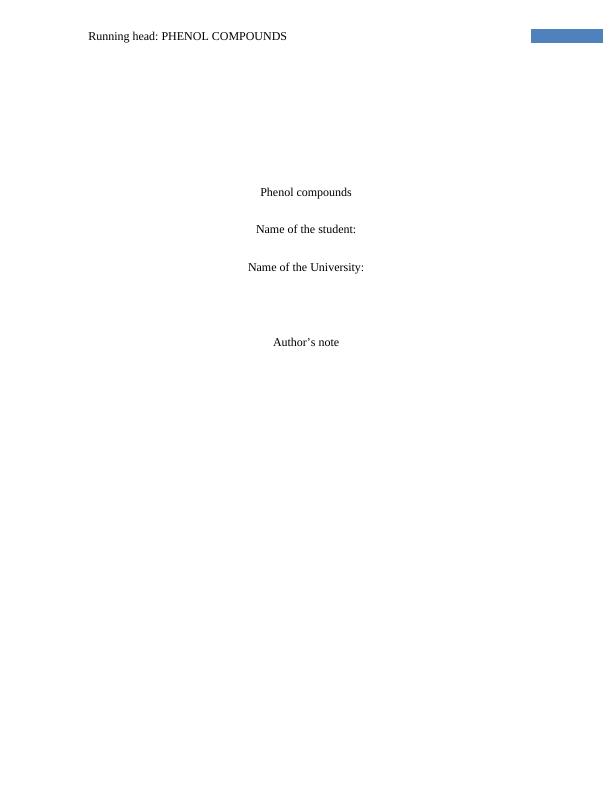
Overview of phenolic compounds:
Phenolic compounds are class of secondary plant metabolites commonly found in
effluents coming out from oil refineries and petroleum industries and they create environment
risk by acting as one major pollutant. It also pollutes the environment by coming out through
wastewater of different industrial effluents like those producing petrochemicals, plastics,
pesticides and pharmaceuticals (Krishnaswamy Veenagayathri, 2015; Wang, Qu, 2009).
According to the European Union and the United States Environmental Protection Agency
(USEPA), the phenolic compounds are likely to have adverse effect on humans and animals.
These properties make it the most toxic primary pollutants.
According to the chemical structure of phenol compounds, it is an compound with six
membered aromatic benzene ring attached to a hydroxyl group. It is a crystalline white solid with
strong odour and most applied in liquid form. The compound is highly soluble in waters and
organic solvents. Its solubility in water is 83 G L-1 at 20 degree Celsius. The product needs
special handling techniques as it can cause burns.
Physical and chemical properties of phenol:
Phenol is mono-substituted aromatic hydrocarbon existing as white or colourless solid in
its pure state. It is commercially available as a liquid product and has sweet acrid smell detected
at 40 ppb in air. It evaporates more slowly in water. A short overview of its physical and
chemical identity is as follows:
Table 1: Physical and chemical properties of phenol. Source: (Review,
2002)
Phenolic compounds are class of secondary plant metabolites commonly found in
effluents coming out from oil refineries and petroleum industries and they create environment
risk by acting as one major pollutant. It also pollutes the environment by coming out through
wastewater of different industrial effluents like those producing petrochemicals, plastics,
pesticides and pharmaceuticals (Krishnaswamy Veenagayathri, 2015; Wang, Qu, 2009).
According to the European Union and the United States Environmental Protection Agency
(USEPA), the phenolic compounds are likely to have adverse effect on humans and animals.
These properties make it the most toxic primary pollutants.
According to the chemical structure of phenol compounds, it is an compound with six
membered aromatic benzene ring attached to a hydroxyl group. It is a crystalline white solid with
strong odour and most applied in liquid form. The compound is highly soluble in waters and
organic solvents. Its solubility in water is 83 G L-1 at 20 degree Celsius. The product needs
special handling techniques as it can cause burns.
Physical and chemical properties of phenol:
Phenol is mono-substituted aromatic hydrocarbon existing as white or colourless solid in
its pure state. It is commercially available as a liquid product and has sweet acrid smell detected
at 40 ppb in air. It evaporates more slowly in water. A short overview of its physical and
chemical identity is as follows:
Table 1: Physical and chemical properties of phenol. Source: (Review,
2002)
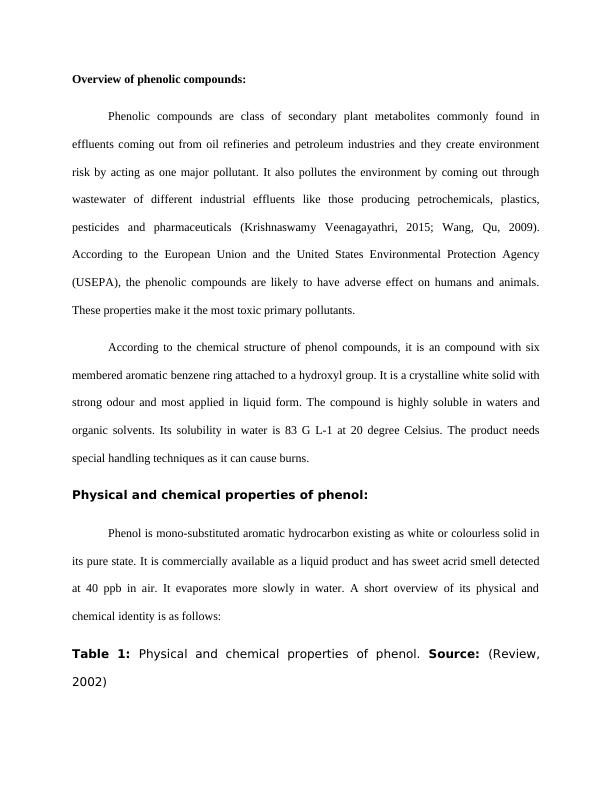
CAS Registry Number 108-95-2
Empirical formula C6H6O
Chemical structure
Synonym(s) Benzenol, phenyl alcohol and phenyl
hydrate,
Registered trade name(s) Carbolic acid, phenic acid,
phenic alcohol
Molecular weight 94.12
Vapor pressure, at 25 0C 0.3513
Boiling point, 0C 181.8
Melting point, 0C 43
Density, at 20 0C relative to the density of H2O
at 4 0C
1.0576
Water solubility, g/L at 25 0C 87
Flashpoint (open cup) 85 0C
Log KOW 1.46
Odor threshold .047 ppm (0.18mg/m3)-100%– response
Conversion factors 1 ppm (v/v) = mg/m3 x 0.260
1 mg/m3 = ppm (v/v) x 3.85
Types of phenolic compounds:
Empirical formula C6H6O
Chemical structure
Synonym(s) Benzenol, phenyl alcohol and phenyl
hydrate,
Registered trade name(s) Carbolic acid, phenic acid,
phenic alcohol
Molecular weight 94.12
Vapor pressure, at 25 0C 0.3513
Boiling point, 0C 181.8
Melting point, 0C 43
Density, at 20 0C relative to the density of H2O
at 4 0C
1.0576
Water solubility, g/L at 25 0C 87
Flashpoint (open cup) 85 0C
Log KOW 1.46
Odor threshold .047 ppm (0.18mg/m3)-100%– response
Conversion factors 1 ppm (v/v) = mg/m3 x 0.260
1 mg/m3 = ppm (v/v) x 3.85
Types of phenolic compounds:

The first member of compounds coming under the phenolic compound group is phenol
also referred to as carbolic acid and benzophenol. The chemical formula for this group is
C6H5OH (Figure 1) and other compounds coming under this group are derivatives of phenol
(Anku, Mamo, & Govender, 2017). The classification of phenolic is done based on various
factors such bases on carbon chain, the number of phenol units present, natural of distribution
and location in plants.
Figure 1: Chemical structure of phenol. Source: (Anku et al., 2017)
Types of phenolic compound based on carbon chain:
Table 2 provides a summary related to the classification of phenol compounds and its
example. The integers attached to the carbon atom indicates the number of carbon atoms that is
attached to benzene ring.
Table 2: Classification of phenolic compounds Source: (Anku et al., 2017)
Carbon
chain
Number of
phenolic units Class Examples
also referred to as carbolic acid and benzophenol. The chemical formula for this group is
C6H5OH (Figure 1) and other compounds coming under this group are derivatives of phenol
(Anku, Mamo, & Govender, 2017). The classification of phenolic is done based on various
factors such bases on carbon chain, the number of phenol units present, natural of distribution
and location in plants.
Figure 1: Chemical structure of phenol. Source: (Anku et al., 2017)
Types of phenolic compound based on carbon chain:
Table 2 provides a summary related to the classification of phenol compounds and its
example. The integers attached to the carbon atom indicates the number of carbon atoms that is
attached to benzene ring.
Table 2: Classification of phenolic compounds Source: (Anku et al., 2017)
Carbon
chain
Number of
phenolic units Class Examples
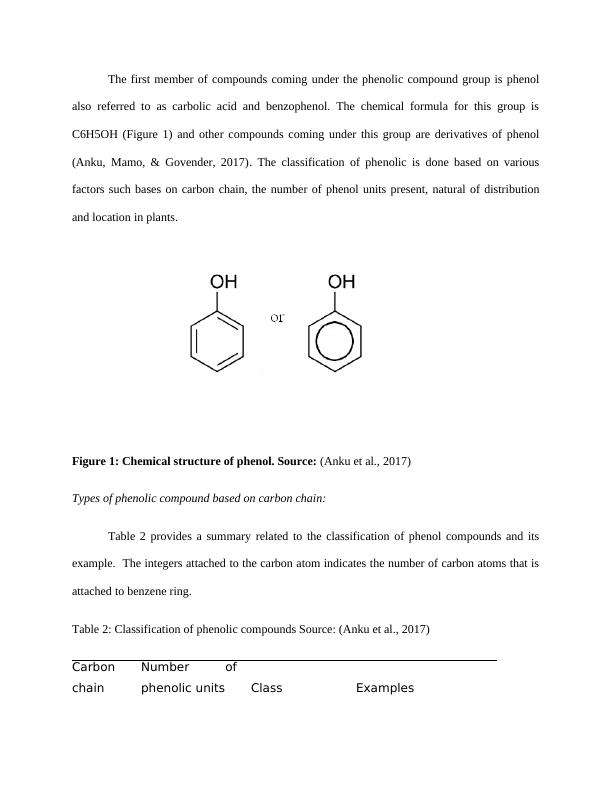
C6 1 Simple phenols Catechol
C6 1 Benzoquinones Hydroquinone
C6‐C1 1 Phenolic acids Gallic
C6‐C2 1
Acetophenone
s 3‐Acetyl‐6‐methoxy
Benzaldehyde
C6‐C2 1
Phenylacetic
acids p‐Hydroxypheylacetic acid
C6‐C3 1
Hydroxycinna
mic acids Caffeic acid
C6‐C3 1
Phenylpropene
s Eugenol
C6‐C3 1
Coumarins/
isocoumarins Umbelliferone
C6‐C3 1 Chromones Cromolyn
C6‐C4 1
Naphthoquino
nes Plumgagin, juglone
C6‐C1‐C6 2 Xanthones Mangiferin
C6‐C2‐C6 2 Stilbenes Resveratrol
C6‐C3‐C6 2 Flavonoids Amentoflavone
(C6‐C3)2 2
Lignans and
neolignans Pinoresinol, eusiderin
(C6‐C3)n n > 12 Lignins Tannic acid
Types of phenolic compound based on number of phenol units:
The phenol compound is grouped into simple, bi and polyphenols based on the number of
phenol groups present in the molecules. Simple phenols are those which have one hydroxyl
C6 1 Benzoquinones Hydroquinone
C6‐C1 1 Phenolic acids Gallic
C6‐C2 1
Acetophenone
s 3‐Acetyl‐6‐methoxy
Benzaldehyde
C6‐C2 1
Phenylacetic
acids p‐Hydroxypheylacetic acid
C6‐C3 1
Hydroxycinna
mic acids Caffeic acid
C6‐C3 1
Phenylpropene
s Eugenol
C6‐C3 1
Coumarins/
isocoumarins Umbelliferone
C6‐C3 1 Chromones Cromolyn
C6‐C4 1
Naphthoquino
nes Plumgagin, juglone
C6‐C1‐C6 2 Xanthones Mangiferin
C6‐C2‐C6 2 Stilbenes Resveratrol
C6‐C3‐C6 2 Flavonoids Amentoflavone
(C6‐C3)2 2
Lignans and
neolignans Pinoresinol, eusiderin
(C6‐C3)n n > 12 Lignins Tannic acid
Types of phenolic compound based on number of phenol units:
The phenol compound is grouped into simple, bi and polyphenols based on the number of
phenol groups present in the molecules. Simple phenols are those which have one hydroxyl
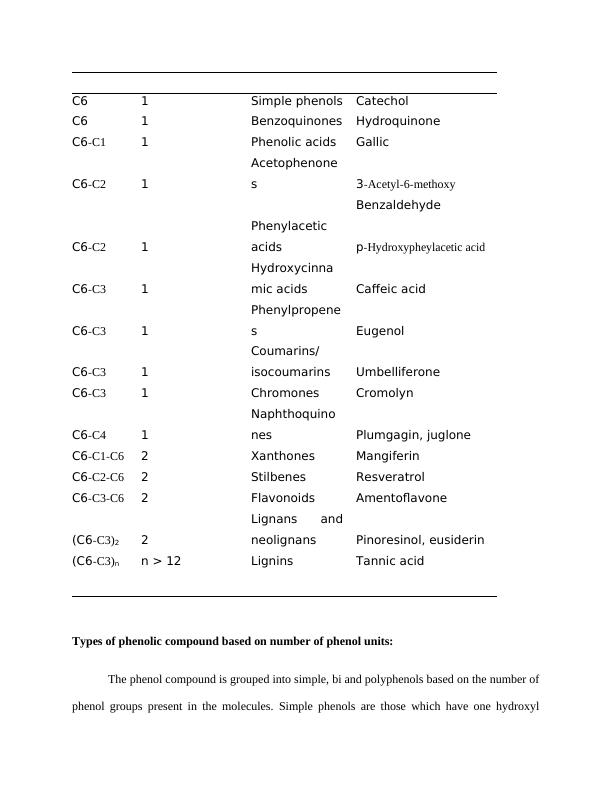
group attached to an aromatic ring. Examples of such compound are resorcinol, thymol and
others (Ignat, Volf & Popa, 2011). In addition, phenols with two phenolic units are known as
biphenols and those with multiple units are known as polyphenols. The polyphenols are further
classified into flavonoids, phenolic acids, tannins, lignans and stilbenes based on number of
phenol rings present and the elements attached to the ring (Archivio et al., 2007). The structure
of each type of simple phenol is illustrated in Figure 2 below:
Figure 2: Structure of simple phenol compounds Source:
Types of phenol compounds based on nature of distribution:
Phenolic compounds are classified as shortly distributed phenols and widely distributed
polymers. Shortly distributed polymers include simple phenols like pyrocatechol and resorcinol
that are less widely found in all plants. In contrast, widely distributed phenols are those that are
available in all plants such as flavonoids, coumarins and cinnamic acid. Some example polymer
class includes tannin and lignin.
Types of phenol compounds based on location in plants:
others (Ignat, Volf & Popa, 2011). In addition, phenols with two phenolic units are known as
biphenols and those with multiple units are known as polyphenols. The polyphenols are further
classified into flavonoids, phenolic acids, tannins, lignans and stilbenes based on number of
phenol rings present and the elements attached to the ring (Archivio et al., 2007). The structure
of each type of simple phenol is illustrated in Figure 2 below:
Figure 2: Structure of simple phenol compounds Source:
Types of phenol compounds based on nature of distribution:
Phenolic compounds are classified as shortly distributed phenols and widely distributed
polymers. Shortly distributed polymers include simple phenols like pyrocatechol and resorcinol
that are less widely found in all plants. In contrast, widely distributed phenols are those that are
available in all plants such as flavonoids, coumarins and cinnamic acid. Some example polymer
class includes tannin and lignin.
Types of phenol compounds based on location in plants:
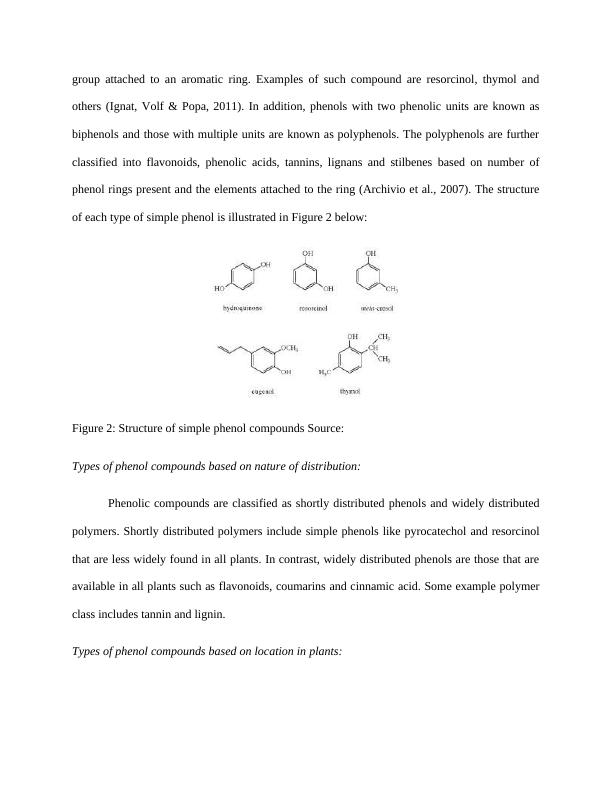
Phenolic compounds that is available in soluble forms in plant cells is known as soluble
forms of phenolic compound and those bound to cell wall is known as insoluble. Soluble
compound include simple phenols, tannins and flavonoid which have low and medium molecular
weight. Example of insoluble phenolic includes those which are bound to polysaccharides in the
cell of wall of plants.
Sources of phenolic compounds in water:
Phenolic compounds exist in aquatic environment because of natural and anthropogenic
activities. Phenolic compounds derived from natural source include decayed dead plants and
animals in water. These are formed by microbial action and plants in the water. In addition,
anthropogenic source of phenolic compounds include those compounds coming from industrial,
domestic ad municipal activities. The following paragraph will provide overview of different
sources of phenols in diverse water bodies.
Source of phenolic compounds:
1. Natural source:
Decomposition or organic matter:
Phenolic compounds exist in water due to decay of deceased plants and animals in the water
bodies and by the accumulation of runoff material from land draining into water bodies. Hence,
they can be derived from plant, aquatic or terrestrial species. Some are found in hemicelluloses
part of plants under ultraviolet rays, whereas others are derived from amino acids. For example,
green and red algae have many phenolic compounds. Hydroxybenzene is synthesized via
decomposition of organic matter (Anku et al. 2017). Phenol is also produced by human body
forms of phenolic compound and those bound to cell wall is known as insoluble. Soluble
compound include simple phenols, tannins and flavonoid which have low and medium molecular
weight. Example of insoluble phenolic includes those which are bound to polysaccharides in the
cell of wall of plants.
Sources of phenolic compounds in water:
Phenolic compounds exist in aquatic environment because of natural and anthropogenic
activities. Phenolic compounds derived from natural source include decayed dead plants and
animals in water. These are formed by microbial action and plants in the water. In addition,
anthropogenic source of phenolic compounds include those compounds coming from industrial,
domestic ad municipal activities. The following paragraph will provide overview of different
sources of phenols in diverse water bodies.
Source of phenolic compounds:
1. Natural source:
Decomposition or organic matter:
Phenolic compounds exist in water due to decay of deceased plants and animals in the water
bodies and by the accumulation of runoff material from land draining into water bodies. Hence,
they can be derived from plant, aquatic or terrestrial species. Some are found in hemicelluloses
part of plants under ultraviolet rays, whereas others are derived from amino acids. For example,
green and red algae have many phenolic compounds. Hydroxybenzene is synthesized via
decomposition of organic matter (Anku et al. 2017). Phenol is also produced by human body
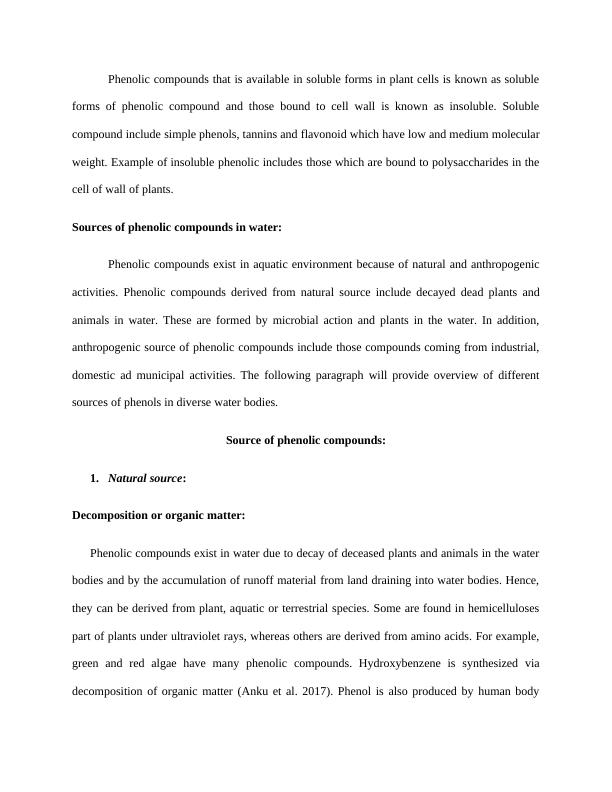
which is ultimately excreted out as phenol compounds in the form of metabolic waste. In case of
mammals, phenol is produced due to embolism of tyrosine in the digestive tract. It is found in
many fruits and vegetables and found naturally in coal tar and creosote. Benzene degradation and
natural fires also lead to production of phenolic compounds.
Action of microorganism:
Anku et al. (2017) has given evidence regarding the role of microorganism in degraded
natural substrates into phenolic compounds. For example, Debaryomyces hansenii is one
microorganism that coverts ferulic acide into various form of phenolic compounds in the
presence of glucose and nitrogen. Max, Tugores, Cortés-Diéguez, & Domínguez, 2012)
identifies that Debaryomyces hansenii produces ferulic acid, vanillin and vanillic acid and
Ghosh, Sachan, Sen, & Mitra, (2007) observed the function of Streptomyces sannanen to convert
feruic acid to vanillic acid. Phenolic compounds are also formed because by the fermentation of
plant extracts. Anku et al. (2017) studied about the use of Lentinus edodes for fermenting
cranberry pomace and Cai et al. (2012) revealed about the action of Aspergillus oryzae in
fermenting ethanolic acid and producing caffeic acid and ferulic acid.
Phenol compound synthesis by plants:
Phenol compounds are widely obtained from various plants. For example, phenolic
compounds are synthesized in chlorophyll because of the influence of stimuli like ultraviolet
radiation and microbial infection. Phenylalanine is the compound in plant that leads to phenolic
compound production. The reaction involves deamination of Phenylalanine to cinnamate through
phenylalanine ammonia lysase catalysis. This is followed by hydroxylation of cinnamate to
coumaric acid catalyzed by cinnamate-4-hydroxylase. Coumaric acid in turn leads to the
mammals, phenol is produced due to embolism of tyrosine in the digestive tract. It is found in
many fruits and vegetables and found naturally in coal tar and creosote. Benzene degradation and
natural fires also lead to production of phenolic compounds.
Action of microorganism:
Anku et al. (2017) has given evidence regarding the role of microorganism in degraded
natural substrates into phenolic compounds. For example, Debaryomyces hansenii is one
microorganism that coverts ferulic acide into various form of phenolic compounds in the
presence of glucose and nitrogen. Max, Tugores, Cortés-Diéguez, & Domínguez, 2012)
identifies that Debaryomyces hansenii produces ferulic acid, vanillin and vanillic acid and
Ghosh, Sachan, Sen, & Mitra, (2007) observed the function of Streptomyces sannanen to convert
feruic acid to vanillic acid. Phenolic compounds are also formed because by the fermentation of
plant extracts. Anku et al. (2017) studied about the use of Lentinus edodes for fermenting
cranberry pomace and Cai et al. (2012) revealed about the action of Aspergillus oryzae in
fermenting ethanolic acid and producing caffeic acid and ferulic acid.
Phenol compound synthesis by plants:
Phenol compounds are widely obtained from various plants. For example, phenolic
compounds are synthesized in chlorophyll because of the influence of stimuli like ultraviolet
radiation and microbial infection. Phenylalanine is the compound in plant that leads to phenolic
compound production. The reaction involves deamination of Phenylalanine to cinnamate through
phenylalanine ammonia lysase catalysis. This is followed by hydroxylation of cinnamate to
coumaric acid catalyzed by cinnamate-4-hydroxylase. Coumaric acid in turn leads to the
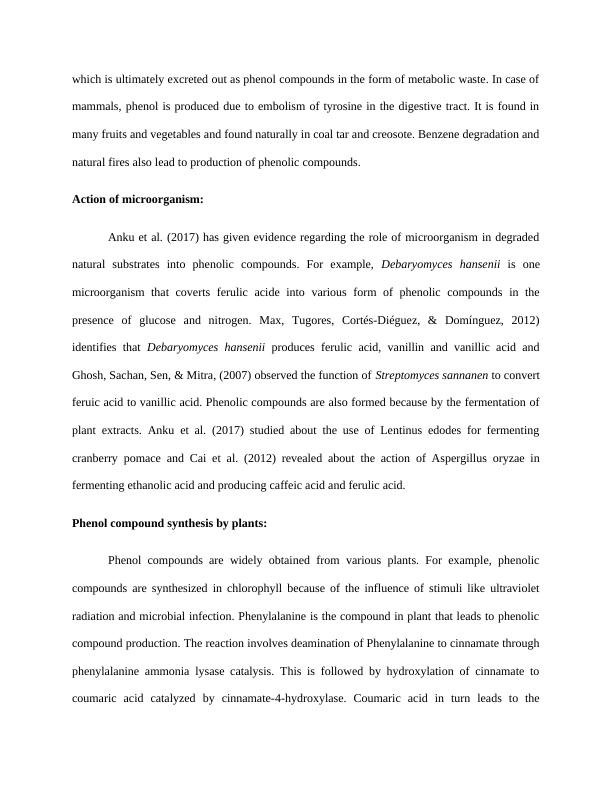
End of preview
Want to access all the pages? Upload your documents or become a member.
Related Documents
Environmental Chemistry: Pesticides, Biogeochemical Cycles, and Pollutantslg...
|7
|1193
|233
